
The Majestic Fish River Canyon: Namibia's Geological Wonder
Discover Fish River Canyon, Namibia's colossal canyon offering stunning vistas, adventurous hiking trails, and unparalleled natural beauty.
Fish River Canyon, located in the southern part of Namibia, is one of the largest canyons in the world. Stretching over 160 kilometers long, it offers breathtaking vistas and a chance to witness nature's grandeur in all its glory. The canyon's sheer cliffs and deep ravines create a dramatic landscape that is both mesmerizing and humbling. Visitors to Fish River Canyon can explore a variety of hiking trails, with the most famous being the Fish River Hiking Trail. This challenging trek spans 85 kilometers and takes about 5 days to complete, offering an unforgettable adventure for avid hikers. Along the way, you'll encounter diverse flora and fauna, as well as natural hot springs where you can relax and rejuvenate. In addition to hiking, the canyon provides excellent opportunities for photography, with its striking rock formations and ever-changing light. The best time to visit is during the cooler months from May to September, when the temperatures are more manageable for outdoor activities. Whether you're a nature enthusiast, a photographer, or simply looking for a unique travel experience, Fish River Canyon promises a memorable journey into one of Namibia's most awe-inspiring natural wonders.
Local tips in Fish River Canyon
- Visit during the cooler months from May to September for the best hiking conditions.
- Ensure you have a permit for the Fish River Hiking Trail, as it is required.
- Pack plenty of water and sun protection; the desert environment can be harsh.
- Consider hiring a guide if you are unfamiliar with the terrain.
- Bring a camera with a good zoom lens to capture the canyon's vastness and details.
The Majestic Fish River Canyon: Namibia's Geological Wonder
Fish River Canyon, located in the southern part of Namibia, is one of the largest canyons in the world. Stretching over 160 kilometers long, it offers breathtaking vistas and a chance to witness nature's grandeur in all its glory. The canyon's sheer cliffs and deep ravines create a dramatic landscape that is both mesmerizing and humbling. Visitors to Fish River Canyon can explore a variety of hiking trails, with the most famous being the Fish River Hiking Trail. This challenging trek spans 85 kilometers and takes about 5 days to complete, offering an unforgettable adventure for avid hikers. Along the way, you'll encounter diverse flora and fauna, as well as natural hot springs where you can relax and rejuvenate. In addition to hiking, the canyon provides excellent opportunities for photography, with its striking rock formations and ever-changing light. The best time to visit is during the cooler months from May to September, when the temperatures are more manageable for outdoor activities. Whether you're a nature enthusiast, a photographer, or simply looking for a unique travel experience, Fish River Canyon promises a memorable journey into one of Namibia's most awe-inspiring natural wonders.
When is the best time to go to Fish River Canyon?
Iconic landmarks you can’t miss
Fish River Canyon Viewpoint
Discover the stunning vistas of Fish River Canyon Viewpoint, an iconic observation deck in Namibia offering breathtaking landscapes and natural beauty.
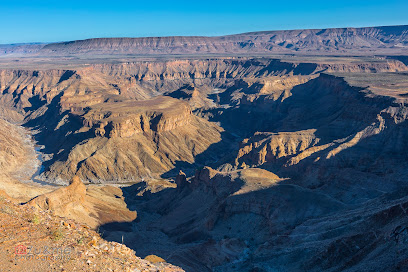
Canyon Lodge, Gondwana Collection Namibia
Discover the beauty of Namibia at Canyon Lodge, your perfect retreat near the magnificent Fish River Canyon.

Canyon Village, Gondwana Collection Namibia
Discover Canyon Village, a serene lodge near Fish River Canyon, blending comfort and adventure in the heart of Namibia’s stunning landscapes.

Fish River Lodge
Immerse yourself in the breathtaking beauty and tranquility of Fish River Lodge, a serene getaway in the heart of Namibia's stunning landscapes.

Fishriver Canyon Hangpoint Lookout
Experience the breathtaking beauty of Namibia at Fish River Canyon Hangpoint Lookout, where nature's majesty unfolds in every direction.

Fishriver Hiking Trail
Experience the breathtaking beauty of the Fish River Hiking Trail, a premier hiking destination in Namibia, where adventure meets stunning landscapes.

Fish river canyon
Discover the breathtaking landscapes and adventurous hiking trails of Fish River Canyon, one of the world's largest canyons located in Namibia.
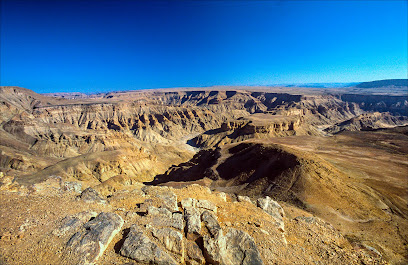
Memorial Plaques
Discover the Memorial Plaques in Hobas, where stunning hikes meet rich history, offering tourists a unique blend of culture and nature in Namibia.

Vasbyt Bend
Explore the breathtaking landscapes and diverse wildlife of Vasbyt Bend, a must-visit hiking area in Namibia's stunning natural surroundings.
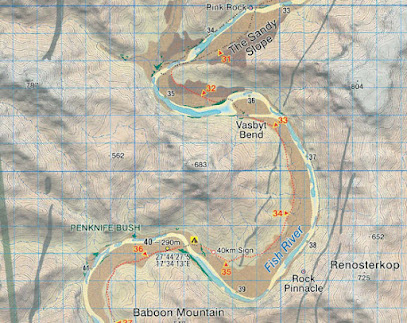
Bandage Pass
Explore Bandage Pass, a hiking paradise in Namibia, where dramatic landscapes and diverse wildlife await every adventurer.

Unmissable attractions to see
Fish River Canyon Viewpoint
Discover the stunning Fish River Canyon Viewpoint, a breathtaking observation deck showcasing one of the world's largest canyons in Namibia.

Hiker's Viewpoint
Discover breathtaking panoramic views at Hiker's Viewpoint, an essential stop for nature lovers and adventure seekers in Hobas, Namibia.

Fishriver Hiking Trail
Uncover the natural beauty of Fishriver Hiking Trail in Namibia, where adventure meets breathtaking landscapes and vibrant wildlife.

Fish river canyon
Discover the breathtaking landscapes and rich geological history of Fish River Canyon, a premier hiking destination in Namibia's stunning wilderness.

Swaelbron lookout
Discover the breathtaking views and serene hiking trails at Swaelbron Lookout in Hobas, a true gem for nature lovers in Namibia.

Sulphur Springs
Explore the picturesque hiking trails of Sulphur Springs, where stunning geothermal features meet breathtaking landscapes in Hobas, Namibia.

Hobas Campsite
Discover the stunning landscapes and outdoor adventures at Hobas Campsite, a must-visit tourist attraction in Namibia.

Sandy Slope (Sand Against Slope)
Discover Sandy Slope: A breathtaking hiking haven near Fish River Canyon, offering stunning views and unforgettable adventures in Namibia’s wilderness.

Four Finger Rock
Discover Four Finger Rock, a breathtaking hiking area in Namibia, featuring stunning landscapes and unique geological formations perfect for outdoor enthusiasts.

Vasbyt Bend
Explore the stunning landscapes and diverse wildlife of Vasbyt Bend, a hiker's paradise in Namibia's breathtaking wilderness.
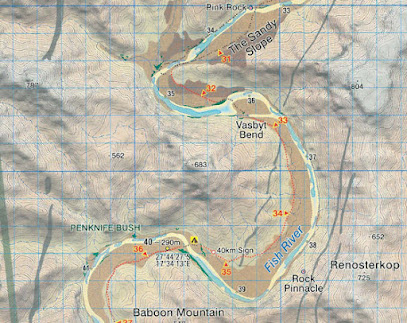
The grave of the German soldier
Explore the historical significance of the Grave of the German Soldier, set against the stunning backdrop of Fish River Canyon in Namibia.

Hell's Corner
Discover the breathtaking landscapes and adventurous trails of Hell's Corner, a premier hiking destination in Namibia's stunning wilderness.

Bandage Pass
Explore the stunning hiking trails of Bandage Pass in Ais-Ais, Namibia, where natural beauty and adventure await every traveler.

Essential places to dine
Canyon Roadhouse, Gondwana Collection Namibia
Discover unparalleled comfort and adventure at Canyon Roadhouse in Namibia – your gateway to breathtaking landscapes and local culture.

Fish River Canyon Viewpoint
Discover unparalleled beauty at Fish River Canyon Viewpoint—Namibia's stunning observation deck showcasing dramatic landscapes.

Canyon Lodge, Gondwana Collection Namibia
Discover the charm of Canyon Lodge, where adventure meets tranquility near Fish River Canyon in breathtaking Namibia.

Canyon Village, Gondwana Collection Namibia
Experience serene lodging at Canyon Village near Fish River Canyon - a perfect blend of adventure and relaxation in Namibia’s stunning landscapes.

Fish River Lodge
Experience breathtaking views and luxurious comfort at Fish River Lodge, an oasis in Namibia's stunning landscapes perfect for adventure seekers and relaxation.

Naute Kristall Cellar and Distillery
Explore Naute Kristall Cellar & Distillery - A Unique Namibian Experience with Exquisite Local Spirits!

The Kokerboom Rosh Pinah
Experience authentic Namibian flavors at The Kokerboom Rosh Pinah – a culinary gem in Rosh Pinah offering a warm atmosphere and delicious dishes.

Fish River Canyon
Explore Fish River Canyon: A breathtaking natural marvel offering stunning views, diverse wildlife, and unforgettable adventures in Namibia's dramatic landscapes.

Fishriver Hiking Trail
Discover breathtaking landscapes and challenging terrains on the iconic Fishriver Hiking Trail in Namibia.

Fish river canyon
Explore Fish River Canyon: A breathtaking hiking destination showcasing nature's grandeur and geological wonders in Namibia.
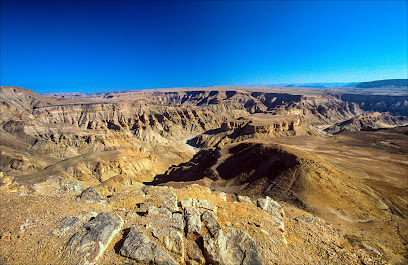
Epata restaurant and accommodation
Discover the delightful flavors of Namibia at Epata Restaurant in Karasburg – where great food meets warm hospitality.

Markets, malls and hidden boutiques
Fish River Canyon Viewpoint
Experience the awe-inspiring beauty of Fish River Canyon at the ultimate observation deck in Namibia, where breathtaking views await every visitor.
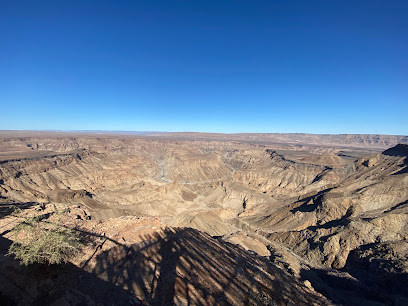
Canyon Lodge, Gondwana Collection Namibia
Experience the tranquility of Canyon Lodge, your gateway to stunning landscapes and adventures near Fish River Canyon in Namibia.

Canyon Village, Gondwana Collection Namibia
Discover the serene beauty of Canyon Village, a unique lodge near Fish River Canyon, offering stunning landscapes and authentic Namibian hospitality.

Canyon Farm Yard
Experience the serenity of nature at Canyon Farm Yard, a perfect blend of camping and delightful refreshments in Keetmanshoop.

Aussenkehr Spar
Experience the vibrant shopping scene at Aussenkehr Spar, where local culture meets convenience in the heart of Namibia.

Fish River Canyon
Experience the awe of Fish River Canyon, one of the world's largest canyons, with breathtaking views, hiking trails, and rich geological history.

TOPS at SPAR Aussenkehr
Explore a wide selection of local wines, beers, and soft drinks at TOPS at SPAR Aussenkehr, your ultimate liquor store destination in Namibia.

PEP Rosh Pinah
Discover trendy clothing for the whole family at PEP Rosh Pinah, where affordability meets quality in a vibrant shopping atmosphere.

Ai-Ais Hot Springs
Experience the healing powers of Ai-Ais Hot Springs, a natural oasis nestled in Namibia's breathtaking landscape, perfect for relaxation and rejuvenation.

Rosh Pinah Deli
Experience the authentic flavors of Rosh Pinah at Rosh Pinah Deli, where fresh ingredients meet local culinary traditions.

Caldeira Supermarket
Discover local flavors and everyday essentials at Caldeira Supermarket in Noordoewer, your go-to general store for a delightful shopping experience.

Shell Fuel
Discover Shell Fuel in Ais-Ais: Your essential stop for fuel, snacks, and travel necessities amidst breathtaking landscapes.

Shop
Discover the essential grocery store in Hobas, offering basic supplies and refreshments for your adventures in Namibia's stunning landscapes.

Elly boy mini market and restaurant
Experience the heart of Rosh Pinah at Elly Boy Mini Market and Restaurant, where local flavors meet friendly service in a cozy atmosphere.

Pep stores
Explore Pep Stores in Karasburg for trendy, affordable clothing that perfectly captures local style and flair.

Essential bars & hidden hideouts
Canyon Roadhouse, Gondwana Collection Namibia
Experience the charm of Namibia at Canyon Roadhouse, where delicious cuisine meets unique local culture in a captivating setting.
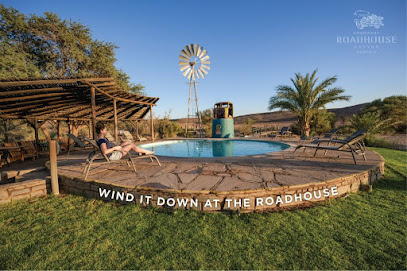
Andy's Pub & Restaurant
Discover the lively ambiance and authentic flavors of Windhoek at Andy's Pub & Restaurant, a local favorite for food and drinks.
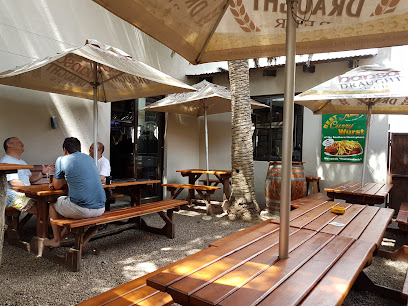
Fish River Canyon Viewpoint
Experience the stunning vistas of Fish River Canyon Viewpoint, one of Namibia's most spectacular natural wonders.
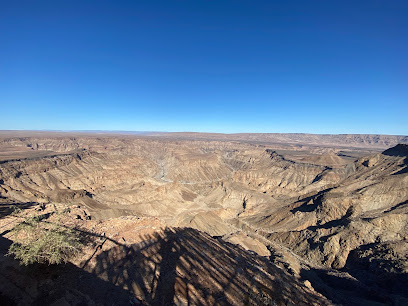
Canyon Lodge, Gondwana Collection Namibia
Discover the breathtaking beauty of Namibia at Canyon Lodge, a serene retreat near the stunning Fish River Canyon, perfect for adventure and relaxation.

Canyon Village, Gondwana Collection Namibia
Discover the breathtaking beauty of Canyon Village, a serene lodge near Fish River Canyon, offering immersive nature experiences and cozy accommodations.

Bar Zonder Naam
Experience the charm of Swakopmund at Bar Zonder Naam, where exquisite wines and delightful bites create unforgettable moments.

Four Seasons Lodge (Bar & Restaurant)
Four Seasons Lodge in Rosh Pinah: A cozy lodge offering delicious meals and comfortable stay in the heart of Namibia’s natural beauty.

Wimpy
Experience the delicious flavors of Wimpy in Noordoewer, a fast-food haven with quality meals and friendly service, perfect for hungry travelers.

The Barrelhouse Bar and Restaurant
Experience the vibrant flavors and lively atmosphere at The Barrelhouse Bar and Restaurant in Keetmanshoop, a must-visit for food and sports lovers.

Chill n' Grill Bar & Restaurant
Discover the vibrant flavors of Namibia at Chill n' Grill Bar & Restaurant, a must-visit spot in Rosh Pinah for food and fun.

Fishriver Canyon Hangpoint Lookout
Discover breathtaking vistas at the Fishriver Canyon Hangpoint Lookout, a natural wonder in Namibia known for its stunning geological formations and serene landscapes.

Dessert Rose
Experience the vibrant atmosphere and delightful drinks at Dessert Rose, the perfect bar for relaxation in Rosh Pinah, Namibia.

Ai Ais Reception and Bar
Discover the serene charm of Ai Ais Reception and Bar, where relaxation meets stunning natural beauty in the heart of Ais Ais.

Desert Fox Spur Namibia
Discover the flavors of Namibia at Desert Fox Spur, where exceptional steak meets authentic African cuisine in a family-friendly setting.

Four Cousins Bar
Experience the vibrant atmosphere and local culture at Four Cousins Bar in Rosh Pinah, offering a delightful selection of drinks and lively entertainment.

Local Phrases about Fish River Canyon
-
- HelloHallo
[HAH-loh] - GoodbyeTotsiens
[TOHT-see-ens] - YesJa
[YAH] - NoNee
[NEH] - Please/You're welcomeAsseblief
[ah-suh-BLEEF] - Thank youDankie
[DAHN-kee] - Excuse me/SorryJammer
[YAHM-mer] - How are you?Hoe gaan dit?
[hoo gahn deet] - Fine. And you?Goed. En jy?
[goot. en yay] - Do you speak English?Praat jy Engels?
[praht yay ENG-uhls] - I don't understandEk verstaan nie
[ek verstahn nee]
- HelloHallo
-
- I'd like to see the menu, pleaseEk wil asseblief die spyskaart sien
[ek vil ah-suh-BLEEF dee spay-skart seen] - I don't eat meatEk eet nie vleis nie
[ek ayt nee flays nee] - Cheers!Gesondheid!
[guh-SUNT-hate] - I would like to pay, pleaseEk wil asseblief betaal
[ek vil ah-suh-BLEEF buh-tahl]
- I'd like to see the menu, pleaseEk wil asseblief die spyskaart sien
-
- Help!Help!
[help] - Go away!Gaan weg!
[gahn veck] - Call the Police!Bel die Polisie!
[bel dee poh-lee-see] - Call a doctor!Bel 'n dokter!
[bel un dohk-tur] - I'm lostEk is verlore
[ek is fuh-lohr-uh] - I'm illEk is siek
[ek is seek]
- Help!Help!
-
- I'd like to buy...Ek wil ... koop
[ek vil kohp] - I'm just lookingEk kyk net
[ek kake net] - How much is it?Hoeveel kos dit?
[hoo-VEEL kohs deet] - That's too expensiveDit is te duur
[deet is teh duhr] - Can you lower the price?Kan jy die prys verminder?
[kahn yay dee prees fuh-MIN-der]
- I'd like to buy...Ek wil ... koop
-
- What time is it?Hoe laat is dit?
[hoo laht is deet] - It's one o'clockDit is een uur
[deet is ayn ohr] - Half past (10)Half tien
[hahlf teen] - MorningOggend
[oh-khent] - AfternoonMiddag
[mi-dahk] - EveningAand
[ahnt] - YesterdayGister
[gih-stur] - TodayVandag
[fuhn-dahk] - TomorrowMôre
[moh-ruh] - 1Een
[ayn] - 2Twee
[tway] - 3Drie
[dree] - 4Vier
[feer] - 5Vyf
[fayf] - 6Ses
[sehs] - 7Sewe
[seh-weh] - 8Agt
[ahght] - 9Nege
[neh-ye] - 10Tien
[teen]
- What time is it?Hoe laat is dit?
-
- Where's a/the...?Waar is 'n/die...?
[vahr is un/dee] - What's the address?Wat is die adres?
[vaht is dee ah-drehs] - Can you show me (on the map)?Kan jy my wys (op die kaart)?
[kahn yay may vays (ohp dee kahrt)] - When's the next (bus)?Wanneer is die volgende (bus)?
[vahn-ehr is dee fuhl-GEN-duh (buhs)] - A ticket (to ....)'n Kaartjie (na ....)
[un kart-chee (nah)]
- Where's a/the...?Waar is 'n/die...?
History of Fish River Canyon
-
The Fish River Canyon is one of the largest canyons in the world, and it owes its dramatic landscape to millions of years of geological activity. The formation of the canyon began about 650 million years ago during the Proterozoic Eon when tectonic activity caused the earth's crust to split, creating a rift valley. Over subsequent millions of years, the Fish River carved its path through the valley, deepening and widening it to create the awe-inspiring canyon we see today.
-
The Fish River Canyon and its surrounding areas were originally inhabited by the San people, also known as the Bushmen. These hunter-gatherers have lived in the region for thousands of years, leaving behind a rich legacy of rock art, tools, and cultural artifacts. The San people were adept at living in the harsh, arid environment of the canyon, relying on their deep knowledge of the land and its resources.
-
The first European to document Fish River Canyon was the German geologist and explorer Friedrich Wilhelm Christian Martin (commonly known as Baron von Wurmb), who visited the area in the late 19th century. His accounts brought the canyon to the attention of the wider world, sparking interest and further exploration. During the German colonial period, the canyon was further mapped and studied, highlighting its geological and ecological significance.
-
During the early 20th century, the Fish River Canyon played a role in the South African and German colonial conflicts. In 1915, during World War I, the South African forces captured the German colony of South West Africa (now Namibia). The rugged terrain of the Fish River Canyon provided a challenging environment for military operations, and skirmishes in the area were part of the broader campaign to control the region.
-
In the mid-20th century, the importance of preserving Fish River Canyon's unique landscape and ecosystems became apparent. Conservation efforts led to the establishment of the Fish River Canyon as part of the Ai-Ais/Richtersveld Transfrontier Park, a collaborative conservation initiative between Namibia and South Africa. This has helped protect the canyon's biodiversity and ensure that it remains a destination for future generations to explore and appreciate.
-
In recent decades, Fish River Canyon has become an increasingly popular destination for tourists seeking adventure and natural beauty. The development of hiking trails, viewpoints, and eco-friendly lodges has made it more accessible to visitors while promoting sustainable tourism practices. The renowned Fish River Hiking Trail, a multi-day trek through the canyon, attracts hikers from around the world, eager to experience its rugged beauty firsthand.
Fish River Canyon Essentials
-
Fish River Canyon is located in the southern part of Namibia. The nearest major airport is Hosea Kutako International Airport in Windhoek, approximately 700 kilometers away. From Windhoek, you can either rent a car and drive to the canyon, which takes around 8 hours, or you can take a domestic flight to Lüderitz or Keetmanshoop, followed by a road trip to the canyon. There are also organized tours that offer transportation from Windhoek to Fish River Canyon.
-
Once at Fish River Canyon, transportation options are limited. Renting a car is the most convenient way to explore the surrounding area at your own pace. There are no public transport services within the canyon itself. Some lodges and hotels may offer shuttle services to key viewpoints and hiking trails. Guided tours are also available for those who prefer not to drive.
-
The official currency in Namibia is the Namibian Dollar (NAD), which is pegged to the South African Rand (ZAR). Credit cards are accepted at most hotels, lodges, and larger restaurants, but it is advisable to carry cash, especially for smaller establishments and when purchasing local crafts. ATMs can be found in nearby towns such as Keetmanshoop, but it is wise to withdraw sufficient cash before arriving at the canyon.
-
Fish River Canyon is generally a safe destination for tourists. However, it is important to take standard precautions such as avoiding isolated areas after dark and keeping valuables secure. There are no specific high-crime areas targeting tourists within the canyon itself, but it is always best to stay vigilant and aware of your surroundings. Ensure you have adequate supplies of water, food, and fuel before embarking on long hikes or drives, as services are limited.
-
In case of emergency, dial 10111 for police assistance or 10177 for medical emergencies. The nearest medical facilities are in Keetmanshoop, approximately 160 kilometers away. It is highly recommended to have travel insurance that covers medical emergencies and evacuation. For minor health issues, carry a well-stocked first aid kit. Inform someone about your travel plans and expected return time when going on hikes.
-
Fashion: Do wear lightweight, breathable clothing suitable for hot and dry conditions. Don’t forget sturdy hiking boots and a wide-brimmed hat. Religion: Do respect local customs and traditions. Public Transport: Do understand that public transport options are limited. Plan accordingly. Greetings: Do greet people with a friendly hello or a handshake. Eating & Drinking: Do try local delicacies and carry sufficient water. Don't litter; keep the natural environment pristine.
-
To experience Fish River Canyon like a local, consider visiting during the off-peak season for a quieter experience. Engage with local guides who can offer in-depth knowledge about the area's geology and history. Make sure to hike the Fish River Canyon Trail if you're up for a challenge; it's one of the most popular multi-day hikes in Southern Africa. Don't miss the opportunity to witness sunrise or sunset at the canyon rim for breathtaking views.
Nearby Cities to Fish River Canyon
-
Things To Do in Lüderitz
-
Things To Do in Mariental
-
Things To Do in Windhoek
-
Things To Do in Walvis Bay
-
Things To Do in Swakopmund
-
Things To Do in Okahandja
-
Things To Do in Karibib
-
Things To Do in Usakos
-
Things To Do in Cape Town
-
Things To Do in Kimberley
-
Things To Do in Omaruru
-
Things To Do in Otjiwarongo
-
Things To Do in Lobatse
-
Things To Do in Bloemfontein
-
Things To Do in Outjo







